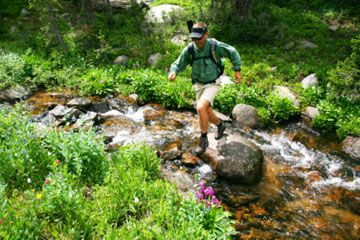For those of us who enjoy spending time in the great outdoors, hiking is a fantastic way not only to enjoy beautiful surroundings, but also to get exercise and challenge ourselves physically. Who better to bring along on your next adventure than man's (and woman's) best friend? Most dogs enjoy being outside even more than we do -- it's a brand-new world of smells, sounds and sights for them to discover. Due to our busy schedules, they often don't get the kind of activity that they really need to stay healthy and happy. Taking your dog along on a hike is a wonderful way to bond, too. It's a win-win situation.
Once you decide to start hiking with your dog, you just pack up the car, drive to your destination and hit the trail, right? Not exactly. Hiking with your dog means taking some extra steps to ensure that both of you have a great time. Not every park or location allows dogs on its hiking trails, so some research is in order. Not every dog is suited to every type of trail, either. And even if you have a dog that's suited to the trail you want to take, you can't just hit the ground running. Just as humans can't go from couch potato to marathon runner, dogs can't go from taking a 15-minute daily walk to going on a 10-mile difficult hike without potentially running into trouble. There are also some important safety tips to keep in mind when you take your dog to an unfamiliar location, and you'll have to think a little differently about how you hike with doggie along.
Advertisement
But don't get discouraged. Read on to learn about everything you can to do make hikes with your dog a fun new part of both of your exercise routines, starting with the prep work.





